Ying Shen
UPN
M3HG: Multimodal, Multi-scale, and Multi-type Node Heterogeneous Graph for Emotion Cause Triplet Extraction in Conversations
Aug 26, 2025Abstract:Emotion Cause Triplet Extraction in Multimodal Conversations (MECTEC) has recently gained significant attention in social media analysis, aiming to extract emotion utterances, cause utterances, and emotion categories simultaneously. However, the scarcity of related datasets, with only one published dataset featuring highly uniform dialogue scenarios, hinders model development in this field. To address this, we introduce MECAD, the first multimodal, multi-scenario MECTEC dataset, comprising 989 conversations from 56 TV series spanning a wide range of dialogue contexts. In addition, existing MECTEC methods fail to explicitly model emotional and causal contexts and neglect the fusion of semantic information at different levels, leading to performance degradation. In this paper, we propose M3HG, a novel model that explicitly captures emotional and causal contexts and effectively fuses contextual information at both inter- and intra-utterance levels via a multimodal heterogeneous graph. Extensive experiments demonstrate the effectiveness of M3HG compared with existing state-of-the-art methods. The codes and dataset are available at https://github.com/redifinition/M3HG.
* 16 pages, 8 figures. Accepted to Findings of ACL 2025
Attention Basin: Why Contextual Position Matters in Large Language Models
Aug 07, 2025Abstract:The performance of Large Language Models (LLMs) is significantly sensitive to the contextual position of information in the input. To investigate the mechanism behind this positional bias, our extensive experiments reveal a consistent phenomenon we term the attention basin: when presented with a sequence of structured items (e.g., retrieved documents or few-shot examples), models systematically assign higher attention to the items at the beginning and end of the sequence, while neglecting those in the middle. Crucially, our analysis further reveals that allocating higher attention to critical information is key to enhancing model performance. Based on these insights, we introduce Attention-Driven Reranking (AttnRank), a two-stage framework that (i) estimates a model's intrinsic positional attention preferences using a small calibration set, and (ii) reorders retrieved documents or few-shot examples to align the most salient content with these high-attention positions. AttnRank is a model-agnostic, training-free, and plug-and-play method with minimal computational overhead. Experiments on multi-hop QA and few-shot in-context learning tasks demonstrate that AttnRank achieves substantial improvements across 10 large language models of varying architectures and scales, without modifying model parameters or training procedures.
LaTtE-Flow: Layerwise Timestep-Expert Flow-based Transformer
Jun 08, 2025Abstract:Recent advances in multimodal foundation models unifying image understanding and generation have opened exciting avenues for tackling a wide range of vision-language tasks within a single framework. Despite progress, existing unified models typically require extensive pretraining and struggle to achieve the same level of performance compared to models dedicated to each task. Additionally, many of these models suffer from slow image generation speeds, limiting their practical deployment in real-time or resource-constrained settings. In this work, we propose Layerwise Timestep-Expert Flow-based Transformer (LaTtE-Flow), a novel and efficient architecture that unifies image understanding and generation within a single multimodal model. LaTtE-Flow builds upon powerful pretrained Vision-Language Models (VLMs) to inherit strong multimodal understanding capabilities, and extends them with a novel Layerwise Timestep Experts flow-based architecture for efficient image generation. LaTtE-Flow distributes the flow-matching process across specialized groups of Transformer layers, each responsible for a distinct subset of timesteps. This design significantly improves sampling efficiency by activating only a small subset of layers at each sampling timestep. To further enhance performance, we propose a Timestep-Conditioned Residual Attention mechanism for efficient information reuse across layers. Experiments demonstrate that LaTtE-Flow achieves strong performance on multimodal understanding tasks, while achieving competitive image generation quality with around 6x faster inference speed compared to recent unified multimodal models.
R2I-Bench: Benchmarking Reasoning-Driven Text-to-Image Generation
May 29, 2025Abstract:Reasoning is a fundamental capability often required in real-world text-to-image (T2I) generation, e.g., generating ``a bitten apple that has been left in the air for more than a week`` necessitates understanding temporal decay and commonsense concepts. While recent T2I models have made impressive progress in producing photorealistic images, their reasoning capability remains underdeveloped and insufficiently evaluated. To bridge this gap, we introduce R2I-Bench, a comprehensive benchmark specifically designed to rigorously assess reasoning-driven T2I generation. R2I-Bench comprises meticulously curated data instances, spanning core reasoning categories, including commonsense, mathematical, logical, compositional, numerical, causal, and concept mixing. To facilitate fine-grained evaluation, we design R2IScore, a QA-style metric based on instance-specific, reasoning-oriented evaluation questions that assess three critical dimensions: text-image alignment, reasoning accuracy, and image quality. Extensive experiments with 16 representative T2I models, including a strong pipeline-based framework that decouples reasoning and generation using the state-of-the-art language and image generation models, demonstrate consistently limited reasoning performance, highlighting the need for more robust, reasoning-aware architectures in the next generation of T2I systems. Project Page: https://r2i-bench.github.io
DetailMaster: Can Your Text-to-Image Model Handle Long Prompts?
May 22, 2025Abstract:While recent text-to-image (T2I) models show impressive capabilities in synthesizing images from brief descriptions, their performance significantly degrades when confronted with long, detail-intensive prompts required in professional applications. We present DetailMaster, the first comprehensive benchmark specifically designed to evaluate T2I models' systematical abilities to handle extended textual inputs that contain complex compositional requirements. Our benchmark introduces four critical evaluation dimensions: Character Attributes, Structured Character Locations, Multi-Dimensional Scene Attributes, and Explicit Spatial/Interactive Relationships. The benchmark comprises long and detail-rich prompts averaging 284.89 tokens, with high quality validated by expert annotators. Evaluation on 7 general-purpose and 5 long-prompt-optimized T2I models reveals critical performance limitations: state-of-the-art models achieve merely ~50% accuracy in key dimensions like attribute binding and spatial reasoning, while all models showing progressive performance degradation as prompt length increases. Our analysis highlights systemic failures in structural comprehension and detail overload handling, motivating future research into architectures with enhanced compositional reasoning. We open-source the dataset, data curation code, and evaluation tools to advance detail-rich T2I generation and enable broad applications that would otherwise be infeasible due to the lack of a dedicated benchmark.
LLM Braces: Straightening Out LLM Predictions with Relevant Sub-Updates
Mar 20, 2025Abstract:Recent findings reveal that much of the knowledge in a Transformer-based Large Language Model (LLM) is encoded in its feed-forward (FFN) layers, where each FNN layer can be interpreted as the summation of sub-updates, each corresponding to a weighted column vector from the FFN's value parameter matrix that often encodes human-interpretable concepts. In light of this, we hypothesize that model performance and behaviors can be further enhanced and controlled by modulating the contributions of these sub-updates based on their relevance to the input or target output style, and propose LLMBRACES, a novel and efficient method that computes relevance scores associated with value vectors in FFN layers and leverages these scores to dynamically adjust the contribution of sub-updates. By optimizing sub-update contributions, LLMBRACES refines the prediction process, leading to more accurate and reliable outputs, much like a 'brace' providing support and stability. Moreover, LLMBRACES can be extended to support conditional control over generation characteristics, such as sentiment, thereby offering fine-grained steering of LLM outputs. Extensive experiments on various LLMs-including Qwen2.5-1.5B, Llama2-7B, and Llama3-8B-demonstrate that LLMBRACES outperforms baseline approaches in both fine-tuning and zero-shot settings while requiring significantly fewer tunable parameters, up to 75% fewer compared to LoRA. Furthermore, LLMBRACES excels in sentiment-controlled generation and toxicity reduction, highlighting its potential for flexible, controlled text generation across applications.
MindGYM: Enhancing Vision-Language Models via Synthetic Self-Challenging Questions
Mar 12, 2025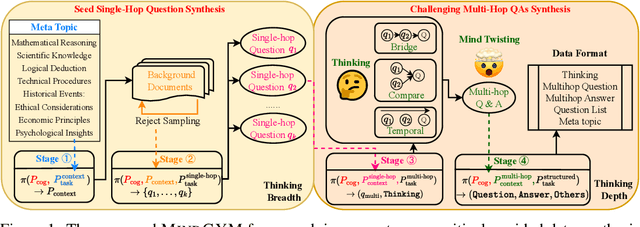
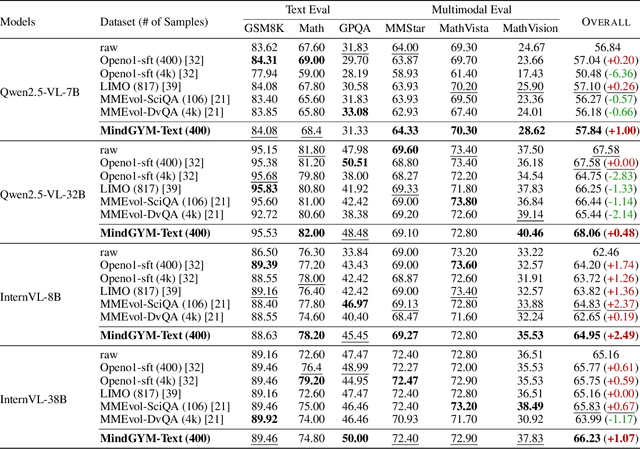

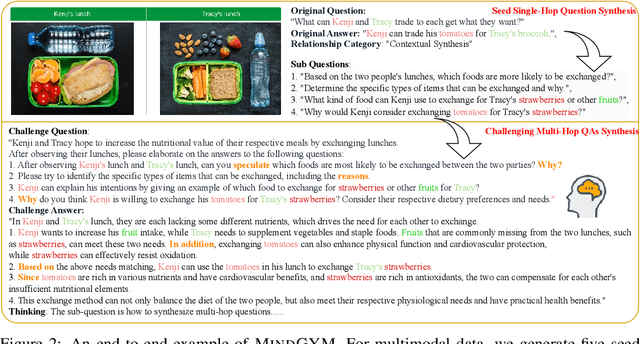
Abstract:Large vision-language models (VLMs) face challenges in achieving robust, transferable reasoning abilities due to reliance on labor-intensive manual instruction datasets or computationally expensive self-supervised methods. To address these issues, we introduce MindGYM, a framework that enhances VLMs through synthetic self-challenging questions, consisting of three stages: (1) Seed Single-Hop Question Synthesis, generating cognitive questions across textual (e.g., logical deduction) and multimodal contexts (e.g., diagram-based queries) spanning eight semantic areas like ethical analysis; (2) Challenging Multi-Hop Question Synthesis, combining seed questions via diverse principles like bridging, visual-textual alignment, to create multi-step problems demanding deeper reasoning; and (3) Thinking-Induced Curriculum Fine-Tuning, a structured pipeline that progressively trains the model from scaffolded reasoning to standalone inference. By leveraging the model's self-synthesis capability, MindGYM achieves high data efficiency (e.g., +16% gains on MathVision-Mini with only 400 samples), computational efficiency (reducing both training and inference costs), and robust generalization across tasks. Extensive evaluations on seven benchmarks demonstrate superior performance over strong baselines, with notable improvements (+15.77% win rates) in reasoning depth and breadth validated via GPT-based scoring. MindGYM underscores the viability of self-challenging for refining VLM capabilities while minimizing human intervention and resource demands. Code and data are released to advance multimodal reasoning research.
A Survey on Mechanistic Interpretability for Multi-Modal Foundation Models
Feb 22, 2025



Abstract:The rise of foundation models has transformed machine learning research, prompting efforts to uncover their inner workings and develop more efficient and reliable applications for better control. While significant progress has been made in interpreting Large Language Models (LLMs), multimodal foundation models (MMFMs) - such as contrastive vision-language models, generative vision-language models, and text-to-image models - pose unique interpretability challenges beyond unimodal frameworks. Despite initial studies, a substantial gap remains between the interpretability of LLMs and MMFMs. This survey explores two key aspects: (1) the adaptation of LLM interpretability methods to multimodal models and (2) understanding the mechanistic differences between unimodal language models and crossmodal systems. By systematically reviewing current MMFM analysis techniques, we propose a structured taxonomy of interpretability methods, compare insights across unimodal and multimodal architectures, and highlight critical research gaps.
Refine Knowledge of Large Language Models via Adaptive Contrastive Learning
Feb 11, 2025Abstract:How to alleviate the hallucinations of Large Language Models (LLMs) has always been the fundamental goal pursued by the LLMs research community. Looking through numerous hallucination-related studies, a mainstream category of methods is to reduce hallucinations by optimizing the knowledge representation of LLMs to change their output. Considering that the core focus of these works is the knowledge acquired by models, and knowledge has long been a central theme in human societal progress, we believe that the process of models refining knowledge can greatly benefit from the way humans learn. In our work, by imitating the human learning process, we design an Adaptive Contrastive Learning strategy. Our method flexibly constructs different positive and negative samples for contrastive learning based on LLMs' actual mastery of knowledge. This strategy helps LLMs consolidate the correct knowledge they already possess, deepen their understanding of the correct knowledge they have encountered but not fully grasped, forget the incorrect knowledge they previously learned, and honestly acknowledge the knowledge they lack. Extensive experiments and detailed analyses on widely used datasets demonstrate the effectiveness of our method.
Diversity as a Reward: Fine-Tuning LLMs on a Mixture of Domain-Undetermined Data
Feb 05, 2025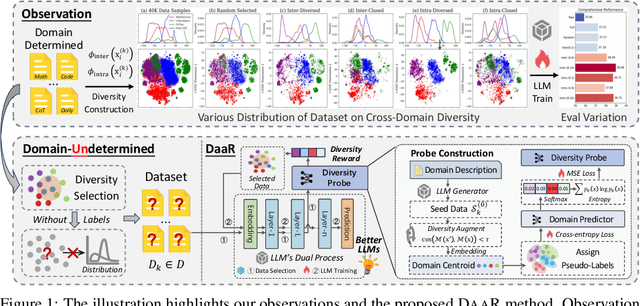
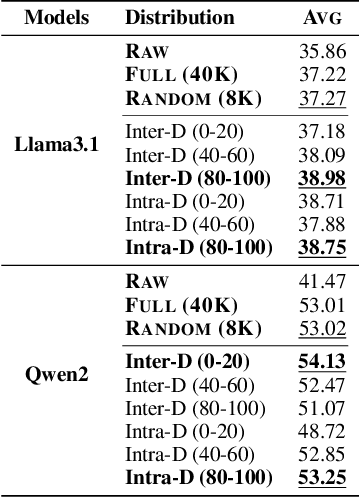
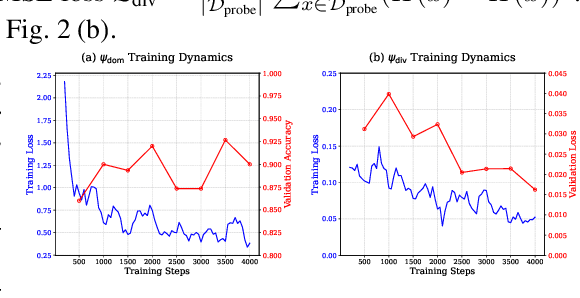
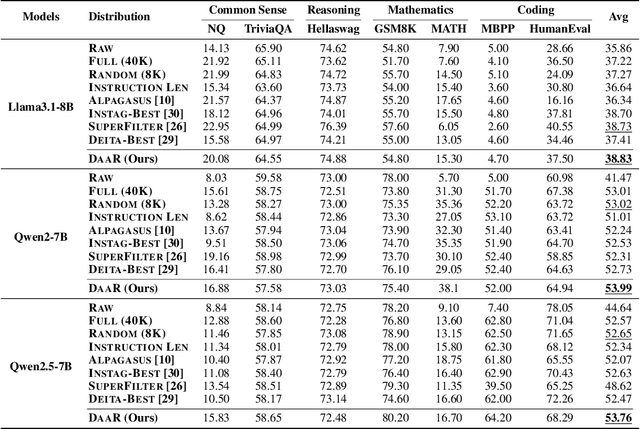
Abstract:Fine-tuning large language models (LLMs) using diverse datasets is crucial for enhancing their overall performance across various domains. In practical scenarios, existing methods based on modeling the mixture proportions of data composition often struggle with data whose domain labels are missing, imprecise or non-normalized, while methods based on data selection usually encounter difficulties in balancing multi-domain performance. To address these challenges, in this paper, we study the role of data diversity in enhancing the overall abilities of LLMs by empirically constructing contrastive data pools and theoretically deriving explanations for both inter- and intra-diversity. Building upon the insights gained, we propose a new method that gives the LLM a dual identity: an output model to cognitively probe and select data based on diversity reward, as well as an input model to be tuned with the selected data. Extensive experiments show that the proposed method notably boosts performance across domain-undetermined data and a series of foundational downstream tasks when applied to various advanced LLMs. We release our code and hope this study can shed light on the understanding of data diversity and advance feedback-driven data-model co-development for LLMs.
 Add to Chrome
Add to Chrome Add to Firefox
Add to Firefox Add to Edge
Add to Edge